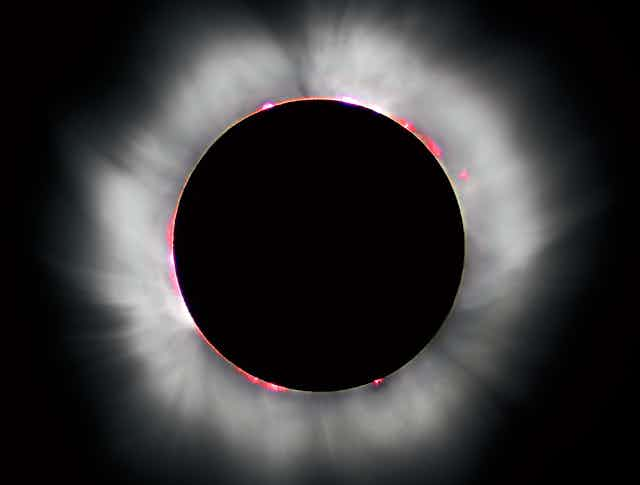A total solar eclipse is an extraordinary visual and emotional experience, from the moon’s first bite out of the sun’s unblemished disc, to the moment that the daylight sky becomes dark and the sun’s blazing light is muted. The temperature drops, the moon’s shadow can be seen speeding across the Earth’s surface, and there is a sudden silence as animals settle down to sleep under the impression that night has fallen.
Yet the fact that we see a solar eclipse at all is something of a miracle. Ours is the only planet in the solar system whose moon appears from the surface to have the same angular size in the sky as that of the sun: it is 400 times smaller, but also 400 times closer. This cosmological coincidence allows the moon to completely block out the sun to reveal the ethereal beauty of its tenuous outer atmosphere, the corona, to those fortunate enough to be standing in the shadow of the moon.
John Couch Adams, who discovered Neptune, wrote in 1851:
The appearance of the corona, shining with a cold unearthly light, made an impression on my mind which can never be effaced, and an involuntary feeling of loneliness and disquietude came upon me.
I consider myself extremely fortunate to have witnessed four total solar eclipses so far. This, my fifth, will be the first solar eclipse visible in Europe since 1999, and the last until 2026. A total solar eclipse happens somewhere on the planet on average every 18 months, but for the moon’s shadow to pass over inhabited land is far less common.

A rare solar eclipse in Europe
The solar eclipse will begin in the mid-Atlantic at sunrise, travelling north-east between Iceland and the UK and Ireland, before ending at the North Pole. The only islands from which totality – the moment when the moon entirely eclipses the sun leaving only a fiery halo – will be visible is remote Svalbard in the Arctic and the Danish-owned Faroe Islands, where I intend to be.
In the UK and Ireland, depending on your location, the maximum coverage will be a partial eclipse of between 85-97% of the sun’s disk, with the degree increasing towards the north. However, even almost entirely occluded in this way, the sun is still bright enough to cause severe eye damage and so precautions must be taken. A partial eclipse is best viewed through special eclipse glasses (not sunglasses), or by projecting the sun’s image onto a piece of white card using a pinhole projector – do not look directly at the sun.

Scientific riches
Aside from being the most awe-inspiring sight in nature, solar eclipses also have immense scientific value. The element helium was discovered as a result of solar eclipse observations, decades before it was detected on Earth. Einstein’s theory of general relativity was proven correct thanks to a solar eclipse, when a star’s apparent position in the sky was “shifted” due to the gravitational influence of the sun. And the technique of spectroscopy led to the discovery that the sun’s corona holds a temperature of over 1,000,000°C – a thousand times hotter than its surface. This has become known as the coronal heating problem, something scientists are still grappling with today. Even now in the 21st century, with advanced scientific instruments both on the ground and in orbit, we cannot reproduce the conditions that nature provides during totality.

The technology we have come to depend upon is at the mercy of catastrophic explosions that originate in the sun’s atmosphere. Solar flares and coronal mass ejections are a consequence of the sun’s contorted coronal magnetic field which, when stretched beyond breaking point, spews plumes of radiation and charged particles in the direction of Earth, putting our electronic infrastructure at risk. Studying the inner corona during a solar eclipse allows us to quantify the state of the sun’s magnetic field, which will help us understand how solar storms get accelerated and the origins of the solar wind, among other things.
It’s a bit late to start planning a North Atlantic trip now, but bear in mind that in August 2017 the moon’s shadow will traverse the entire continental US, from Oregon to the Carolinas, making it one of the most accessible total eclipses of a generation. If you possess any sense of wonder and adventure, then you owe it to yourself to find a way of experiencing this fascinating phenomenon first hand. Then you can join in the chorus heard after the moon’s shadow has passed: “When is the next one?”

